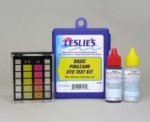So I posted on here awhile back about my cloudy pool about to drive me over the edge and was advised that I needed to get a good testing kit..which I haven't got yet but am hoping to get in the next week or two. Couple questions. First about my cloudiness and then about test kits. Short background on it....pool was originally cleaned and set up late last summer.....left water in it over the winter....was still clean and clear but when we were getting ready to open it up this year there was some dirty water on the top of the cover that got spilled into the pool. It was yucky green but we got that cleared up pretty easily but every since then it has been real cloudy......so cloudy to where you couldn't see the bottom of the pool. Well here about a week or two ago I noticed that you could see the bottom good enough that I could barely see where a little pile of debris was laying and I was excited about that because I had been been vacuuming it out without being able to see what I was vacuuming. Well sadly the pool is under two trees so I think leaves and etc are going to be a daily problem but last night when I went down to look at the pool it looked way clearer then it had since this all began about 2 months ago LOL I could not only see a small pile of debris (again) I could see pretty much the whole floor and it was kinda clear around the outer edge and just a little cloudy in the middle of the pool....no I vacuumed out the pile I seen and then decided to get in and vacuum it out too......well in the process of me being in there it ALL got real cloudy again and for the most part I couldn't see the bottom of the pool except in little areas here and there. So I'm wondering if me being in it could make it go from very little cloudy to way more cloudy and if so why? Just stirring up dirty/debris on the bottom or what? Any suggestions? Or do I need to get a good test kit before anything can or should be done to try to fix the cloudiness? Which leads me to my next question.....
What type of test kit do you recommend...the least expensive. What all does it need to test for. I know with the strips it tests for Total Hardness, Total Chlorine, Free Chlorine, Alkalinity and Stabilizer. I think I was advised before that you don't need to know total chlorine but you need to know combine chlorine which isn't on the test strips so if some people could give me names of tests that are good but not too expensive I would appreciate it.
BTW....my pool is an above ground pool.......I believe it's a 15X42 (it's my b/f's so that's why I'm not 100% sure) and it is a vinyl on with a sand filter pump on it.
Thanks for anything anyone has to offer me
What type of test kit do you recommend...the least expensive. What all does it need to test for. I know with the strips it tests for Total Hardness, Total Chlorine, Free Chlorine, Alkalinity and Stabilizer. I think I was advised before that you don't need to know total chlorine but you need to know combine chlorine which isn't on the test strips so if some people could give me names of tests that are good but not too expensive I would appreciate it.
BTW....my pool is an above ground pool.......I believe it's a 15X42 (it's my b/f's so that's why I'm not 100% sure) and it is a vinyl on with a sand filter pump on it.
Thanks for anything anyone has to offer me


